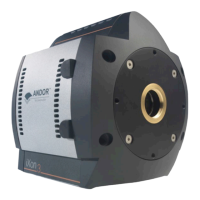Page 54
Features & Functionality
3.7 - COUNT CONVERT
OneofthedistinctivefeaturesoftheiXon3isthecapabilitytoquantitativelycaptureandpresentdatainunitsof
electrons or photons, the conversion applied either in real time or as a post-conversion step. Photons that are incident
on pixels of an array detector are captured and converted to electrons. During a given exposure time, the signal in
electrons that is collected in each pixel is proportional to the signal intensity. In EMCCDs, the signal in electrons is further
multiplied in the EM gain register. The average multiplication factor is selected in software from the RealGain™ scale. It
can be desirable to directly quantify signal intensity either in terms of electrons per pixel or in terms of incident photons
per pixel. However, during the readout process, array detectors must rst convert the signal in electrons (the multiplied
signal in the case of EMCCDs) into a voltage which is then digitized by an Analogue to Digital Converter (ADC). Each
Analogue to Digital Unit (ADU) is presented as a ‘count’ in the signal intensity scale, each count corresponding to an
exact number of electrons. Furthermore, the signal value in counts will sit on top of an electronic bias offset value. In the
iXon3 this ‘baseline’ can be clamped at 100 counts.
Therefore, in order to back calculate to the original signal in electrons, electron to ADU conversion factor must be very
accurately stored by the camera (which varies depending on the pre-amplier gain selection chosen through software).
Calculation of the signal as absolute electrons also requires knowledge of the bias offset and the EM Gain. The
calculation path is shown in gure 40 below:
Furthermore, knowledge of the Quantum Efciency (QE) at each wavelength and light throughput properties of the
camera window enables this process to be taken a step further, allowing the signal to be estimated in photons incident
ateachpixel.Forthisstep,theusermustinputthesignalwavelength.Inuorescencemicroscopyforexample,this
wouldcorrespondtothecentralwavelengthdenedbyanarrowbandemissionltermatchedtotheuorophoreof
interest. If the spectral coverage of the signal on the detector is too broad, such that the QE curve varies signicantly
throughout this range, then the accuracy of the incident photon estimation would be compromised.
TheCountConvertfunctionalityoftheiXon3providestheexibilitytoacquiredataineitherelectronsorincident
photons, with negligible slow down in display rate. Furthermore, the option exists to record the original data in counts
and perform this important conversion to either electrons or photons as a post-conversion step, while retaining the
original data.
Figure 40: Count Convert calculation path

